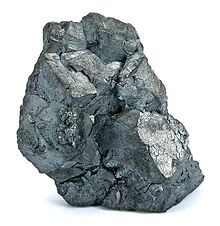
Back أرجيروديت Arabic Argirodita Catalan Argyrodit German Αργυροδίτης Greek Argirodita Spanish Argirodita Basque Argyrodite French Argirodit Hungarian Argirodite Italian Argyrodiet LI
| Argyrodite | |
|---|---|
 | |
| General | |
| Category | Sulfide mineral |
| Formula (repeating unit) | Ag8GeS6 |
| IMA symbol | Agy[1] |
| Strunz classification | 2.BA.35 |
| Crystal system | Orthorhombic |
| Crystal class | Pyramidal (mm2) H-M symbol: (mm2) |
| Space group | Pna21 |
| Unit cell | a = 15.149, b = 7.476 c = 10.589 [Å]; Z = 4 |
| Identification | |
| Color | Black, purplish tinge |
| Crystal habit | Pseudo-octahedra or pseudo-cubic, dodecahedra, cubes; radiating crystal aggregates, botryoidal crusts, or massive |
| Twinning | Pseudospinel law {111} penetration twins |
| Cleavage | Absent |
| Fracture | Uneven to conchoidal |
| Mohs scale hardness | 2.5 |
| Luster | Metallic |
| Diaphaneity | Opaque |
| Specific gravity | 6.2-6.5 |
| Optical properties | Weakly anisotropic |
| Pleochroism | Weak |
| References | [2][3] |
Argyrodite is an uncommon silver germanium sulfide mineral with formula Ag8GeS6. The color is iron-black with a purplish tinge, and the luster metallic.
Discovered and named by Albin Weisbach in 1886,[4] it is of interest as it was the material from which Clemens Winkler isolated the element germanium, 15 years after it had been postulated by Mendeleev. It was first described for an occurrence in the Himmelsfürst Mine, Ore Mountains, Freiberg, Saxony, Germany.[3]
The Freiberg mineral had previously been imperfectly described by August Breithaupt under the name "Plusinglanz", and Bolivian crystals were incorrectly described in 1849 as crystallized brongniardite.[5]
Isomorphous with argyrodite is the corresponding tin bearing mineral Ag8SnS6, also found in Bolivia as pseudocubic crystals, and known by the name canfieldite.[5] There is also a related mineral, putzite, with composition (Cu4.7Ag3.3)GeS6.
Argyrodite gets its name from the Greek words that loosely translate into "rich in silver".[2]
- ^ Warr, L.N. (2021). "IMA–CNMNC approved mineral symbols". Mineralogical Magazine. 85 (3): 291–320. Bibcode:2021MinM...85..291W. doi:10.1180/mgm.2021.43. S2CID 235729616.
- ^ a b Handbook of Mineralogy
- ^ a b Mindat.org
- ^ Weisbach, Albin (1886). "Argyrodit, ein neues Silbererz". Neues Jahrbuch für Geologie und Paläontologie. 2: 67.
- ^ a b Spencer 1911, p. 488.
© MMXXIII Rich X Search. We shall prevail. All rights reserved. Rich X Search